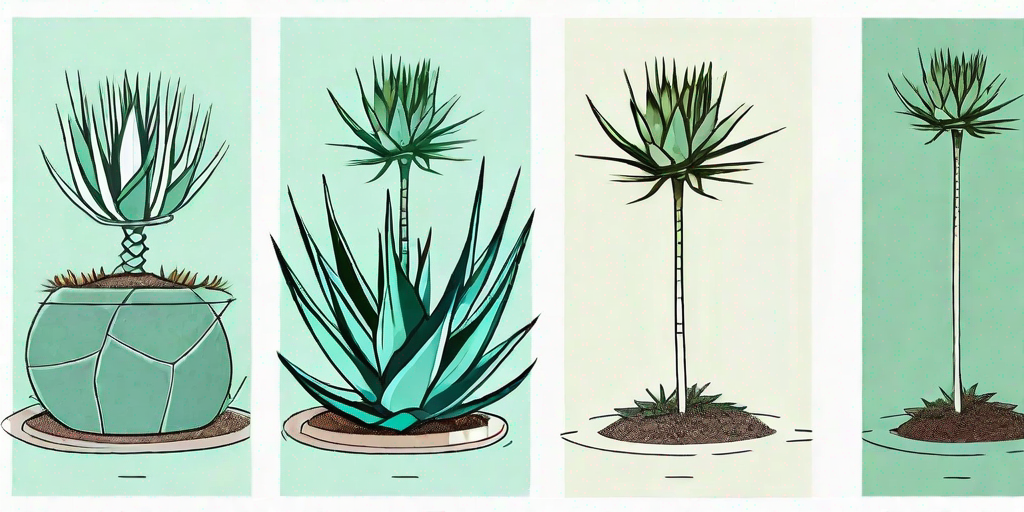
Ah, the agave plant. A symbol of the arid desert, a staple in Mexican culture, and the mother of all margaritas. But did you know that this spiky superstar is also a dream come true for gardeners and landscapers? That's right, folks. Today, we're going to delve into the world of agave propagation. So, grab your gardening gloves and let's get dirty!
The Agave Plant: A Brief Introduction
Before we dive into the nitty-gritty of propagation, let's take a moment to appreciate the beauty and versatility of the agave plant. Native to the hot and arid regions of the Americas, agave plants are renowned for their ability to survive in harsh conditions. They're like the Chuck Norris of the plant world.
Agave plants come in a variety of shapes and sizes, from small rosettes to towering giants. They're also known for their long, sharp, and often spiky leaves. But don't let their prickly exterior fool you. These plants are full of surprises. For instance, did you know that some agave plants can live for up to 100 years? Now that's what I call a commitment!
The Many Uses of Agave
Agave plants are not just pretty to look at. They're also incredibly useful. The Aztecs used agave for everything from food and drink to medicine and fiber. Today, we mostly know agave for its sweet nectar, which is used as a natural sweetener, and for its role in producing tequila. Yes, you read that right. Without agave, there would be no tequila. Let that sink in for a moment.
But the uses of agave don't stop there. Agave is also a popular choice for landscaping, thanks to its low maintenance requirements and striking appearance. Plus, it's a great way to add a touch of the exotic to your garden. Who needs a trip to Mexico when you can bring Mexico to your backyard?
How to Propagate Agave: A Step-by-Step Guide
Now that we've covered the basics, it's time to roll up our sleeves and get to work. Propagating agave is surprisingly easy, even for those of us who don't have a green thumb. All you need is a bit of patience, a dash of care, and a whole lot of love.
Step 1: Choose Your Method
There are two main ways to propagate agave: by seeds or by offsets. Seeds can be a bit tricky and require more time and care. Offsets, on the other hand, are like little baby agaves that grow at the base of the mother plant. They're basically ready-made plants, just waiting to be potted. For beginners, I recommend starting with offsets.
Step 2: Remove the Offset
Removing the offset is a delicate process. You'll need a sharp knife or a pair of gardening shears. Make a clean cut at the base of the offset, making sure not to damage the mother plant. Remember, agave plants are tough, but they're not invincible.
Step 3: Let it Heal
Once you've removed the offset, you'll need to let it heal for a few days. This means leaving it in a cool, dry place until the cut end has dried and formed a callus. This step is crucial as it helps prevent the offset from rotting when you plant it.
Step 4: Plant the Offset
Now comes the fun part: planting. Fill a pot with well-draining soil (cactus mix works great) and make a small hole in the center. Place the offset in the hole, callus-end down, and gently cover with soil. Water sparingly until the plant is established.
Common Mistakes and How to Avoid Them
As with any gardening endeavor, there are a few common mistakes that can turn your agave propagation dream into a nightmare. But fear not, dear reader. I'm here to guide you through the pitfalls and help you avoid the common blunders.
Overwatering
Agave plants are desert dwellers, which means they're not big fans of water. Overwatering is a common mistake that can lead to root rot and ultimately, the death of your plant. So, when it comes to watering, remember: less is more.
Not Enough Light
Agave plants love the sun. In fact, they need at least six hours of sunlight a day to thrive. So, if you're planning on keeping your agave indoors, make sure to place it near a sunny window. If you're planting it outdoors, choose a spot that gets plenty of sun.
FAQs
How long does it take for an agave plant to grow?
The growth rate of an agave plant depends on the species and the conditions in which it's grown. Some species can reach full size in just a few years, while others may take decades. Patience is key when growing agave.
Can I grow agave indoors?
Absolutely! Agave plants can make great houseplants, as long as they get enough light. Just remember to go easy on the watering.
How often should I water my agave plant?
As a rule of thumb, you should water your agave plant once a week in the summer and once a month in the winter. However, always check the soil before watering. If it's still moist, hold off on the water.
Conclusion
And there you have it, folks. A comprehensive guide on how to propagate agave like a pro. Whether you're a seasoned gardener or a complete newbie, I hope this article has inspired you to give agave propagation a go. After all, who wouldn't want a piece of the desert in their own backyard? Plus, think of all the margaritas you could make!
So, what are you waiting for? Grab your gardening tools, put on your favorite sombrero, and get planting. And remember, when it comes to agave propagation, the sky's the limit. Happy gardening!















